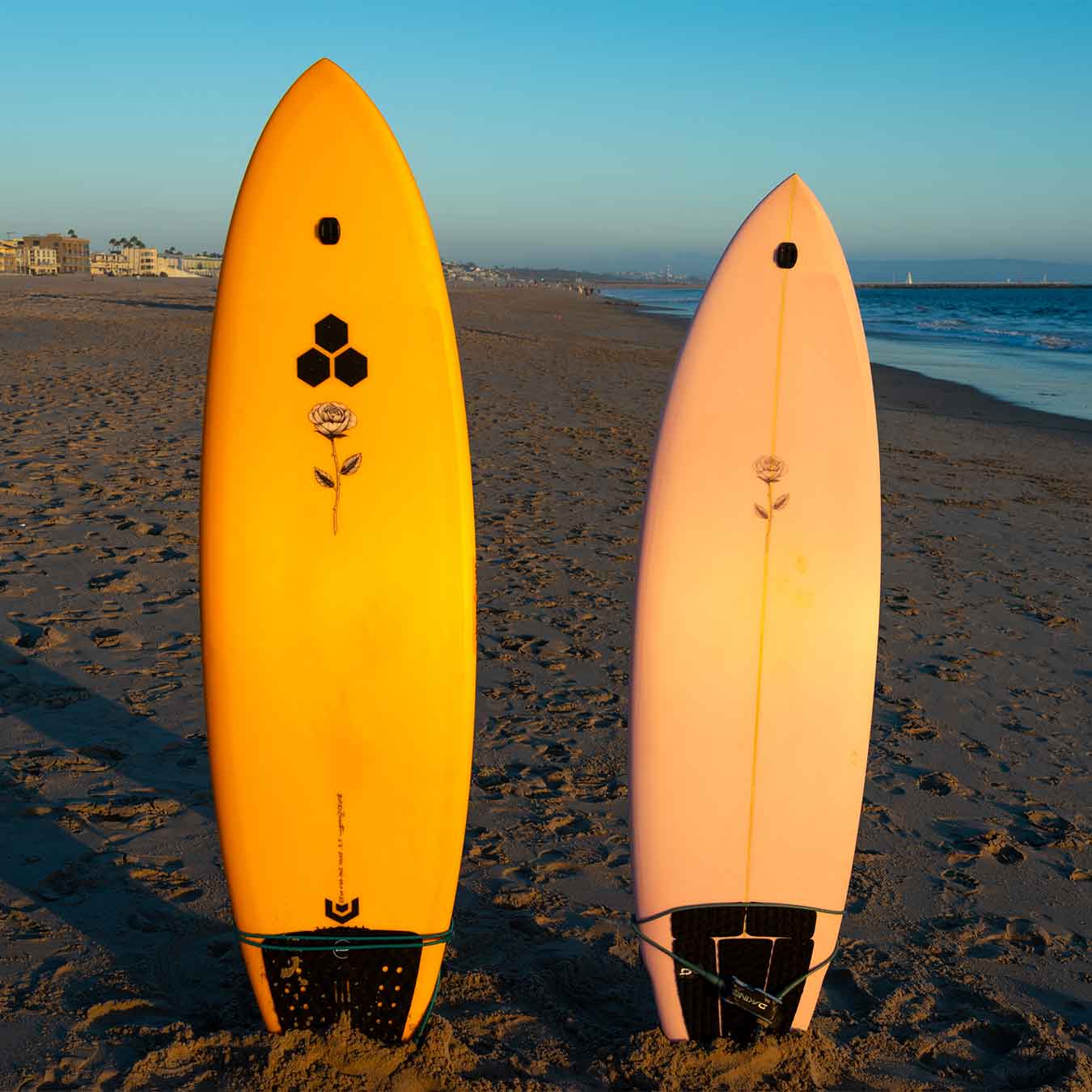The main reason to buy a custom surfboard is because you can’t find the board you want on a shelf. A custom surfboard is a big step in a surfer’s journey, and it can bring noticeable, tangible benefits to the way you surf and how much fun you have. Ideally, you’ll end up with a board that is a sublime match for your body, style, goals, and the waves you frequent. But it can also be an overwhelming experience (and a not-insignificant investment in time and money), so you want to get it right.
Luckily for you, we’ve got it covered. I worked with two legendary shapers—Britt Merrick and Guy Okazaki—and went through the custom shaping process (twice), in order to bring you this comprehensive guide to ordering a custom surfboard—complete with what to expect, the questions to ask, the information you’ll need, and the pitfalls to avoid.
Step One: Do Your Research
The first step is to try as many different boards as you can. Your local surf shop, OfferUp, Craigslist, and Facebook Marketplace are all great resources for this. I spent $350 on a used surfboard from Craigslist, rode it for a little while, then sold it to someone else for $350, and bought something else to play with. Used boards can hold their value well if you don’t damage them. Also, look for demo days at your local surf shop.
“I have a friend who’s a really good surfer, and for the last few years, he’s just been buying the most random boards off Craigslist,” up-and-coming Venice pro surfer told me. “But now he’s in this phase where he knows exactly what he wants because he’s tried so many boards. So now when he goes to a shaper, he has all this knowledge to pull from.”
The next phase of your research should be to talk to other surfers. Look for surfers right around your size and ability level at your local breaks and ask them what they’re on and how they like it. If you can afford it, hire an experienced coach for a session or two, and see what suggestions they might have for your next surfboard. The web is also a great resource. Both the Pyzel and Channel Islands websites have live chats with actual humans on the other end, and they are extremely knowledgeable and helpful. They can help you get a better handle on what might, and what might not work for you (just be respectful of their time).
Step Two: Pick Your Surfboard Shaper
Find a shaper who will take the time to understand where you’re at and where you want to go and ensure they have the skills to make the right board for the job. A good shaper carries a wealth of knowledge about surfboard design and surfing in general. It may also give you an opportunity to work with a local who has deep insights about the waves you’ll be surfing the most, and you get to support the local surf economy.
I went into this quest knowing that I wanted two boards: A point-break specialist for some of my favorite spots in Malibu and Ventura, and a hyper-local board for the beach break I surf in Venice 80 percent of the time. After months of research, I found my two dream shapers.
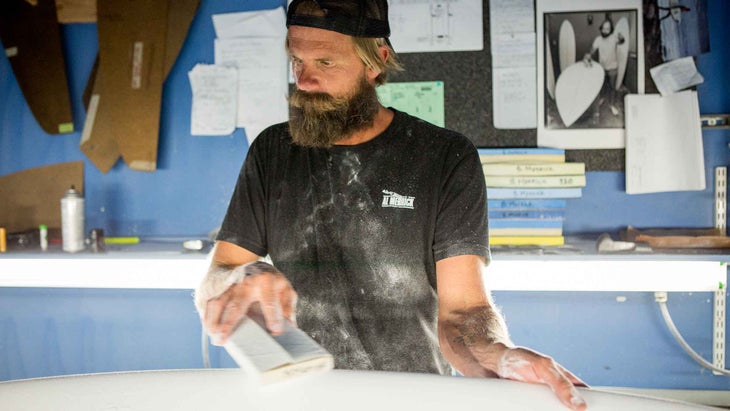
Britt Merrick,
Britt was literally raised in a surfboard factory, as the son of world renown shaper and founder of Channel Islands Surfboards, Al Merrick. He would grow up to become an iconic shaper in his own right, making award-winning surfboards (including several winners) for WSL Championship Tour event winners and average joes alike. Channel Islands is based in Santa Barbara, home to legendary point breaks like Rincon, and considering how many boards he’s made for people who compete at places Jeffreys Bay and Snapper Rocks, I figured he’d be the perfect person to make my point break killer. Note: anyone can request a board from Britt, but it will most likely take months longer than usual because he has a massive queue.
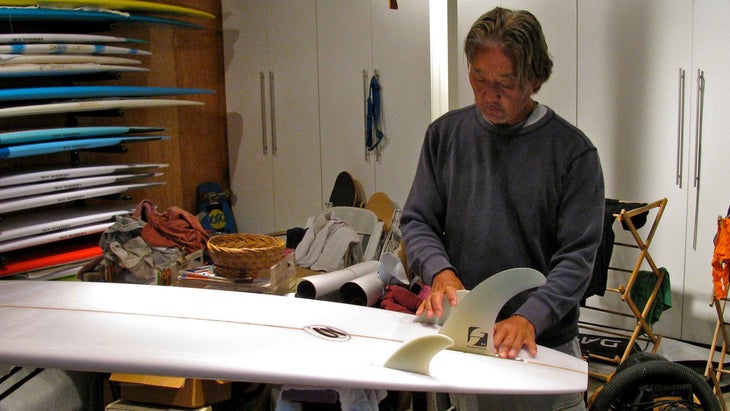 Surfboard shaper Guy Okazaki at work (Photo: Courtesy Guy Okazaki)
Surfboard shaper Guy Okazaki at work (Photo: Courtesy Guy Okazaki)
Guy Okazaki,
When it came to finding a shaper for my Venice beach break board, I knew exactly who I hoped would make it. It seemed like 20 percent of the boards I would see at my favorite spot had a big “GOS” stamped on the deck. Plus, Okazaki has been surfing here since the 1950s, so not many people know the wave better. Okazaki was born in Hawaii, where he first learned to shape surfboards from his dad and legends of the sport, including Rabbit Kekai. He would go on to travel and surf with world champions, and he’s been shaping boards in his garage in Venice for more than 30 years. For my usual spot, Guy is as local as it gets, and every surfer I talked to raved about his boards.
This brings up an important point: You want to pick your shaper based on their strengths and based on what you’re looking for. I determined that Merrick and Okazaki were likely the best fit for my specific criteria, but if I wanted a surfboard for Hawaii, then maybe Wade Tokoro or John Pyzel would be the move.
Step 3: Talk with Your Shaper
Set up a phone call (or an in-person meeting if you can) with the shaper to discuss the board. You should familiarize yourself with the boards they make because chances are high that they will be using one of those models as a starting point.
Typically, shapers will first ask about your height and weight. Then they’ll likely ask your age and how often you surf to determine how much board you need. Next, all that time you spent trying different boards will come in handy when they ask you what you have been riding and how they worked (or didn’t work) for you.
When I asked Merrick and Okazaki what the most important factor is for determining the right board, they had the same answer: it depends on where and how you surf now, and where and how you’re hoping to in the near future.
The “where” questions to ask yourself: Are you mostly going to be surfing beach breaks, point breaks, or reef breaks? This is where a shaper with knowledge of your preferred breaks can come in handy. And what size waves will you be on, realistically?
The “how” is a bit harder to quantify. What do you want to do on the wave? What do you enjoy now, and where would you like to get in in the next few years? For example, I told the shapers that I really want to improve my carving, work on speed generation, and build confidence in steeper barreling waves. For me, these are modest but realistic goals for where I am in my evolution as a surfer.
Pitfalls to Avoid
- Don’t let your ego get in the way. I get it—nobody wants to seem like a kook, but you have to avoid over-inflating your skills. “That’s the most common mistake people make,” Merrick told me. “If they don’t have realistic expectations and goals, then they tend to get the wrong board altogether. Usually, that means not getting enough surfboard. Especially with beginners, they get small boards like the pros, and they don’t have the paddling power, so they miss a ton of waves. You’ve also got to start making adjustments for your physicality, and age.”
- Don’t forget to be specific. Terms like Beginner, Intermediate, Advanced, and Expert, are extremely nebulous. Tell your shaper the things you feel like you’re doing well, and tell them the things you’re struggling with. Video clips can tell a shaper a lot about where you’re at, and their experienced eyes will likely spot things in your surfing that you don’t even know to look for. Get a friend to film you from shore, and show them a mix of your best and worst waves to give them the most accurate picture.
- Don’t fall into the current obsession with surfboard volume. It’s not that volume isn’t important, but it’s not that helpful on its own. Okazaki broke it down: “Over the last few years, the first metric out of someone’s mouth has been volume, and I always chuckle, ‘Well, where do you want that volume? Do you want it in the middle, in the nose, in the tail, distributed uniformly? Do you want it on the rails or more in the center?’ And they realize that they hadn’t given that a thought. Where that volume is is really more important than what the volume is.”
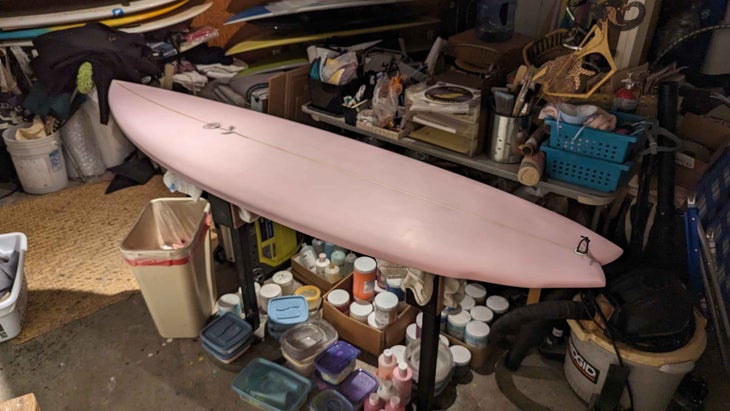
Step 4: Finishing Touches
While you and your shaper talk, they’ll be taking down your decisions in an order form. This is also where you’ll make choices about which type of fin-boxes you want, and how many. You’ll decide whether you want a traditional foam or EPS, what type of fiberglass (or carbon fiber), how heavy, and whether you’d like to use polyurethane resin or epoxy. Each of these things will affect the way your board performs to different degrees, and while whole articles have been written about each of those categories, again, talk to your shaper about what they think would work best for the design you’ve agreed on.
This is also where you’ll make a decision about art. Do you want to leave the board white, or add a tint to the resin? Or a swirl? Do you have some art you would like laminated onto the deck? These things are a personal touch that make the board feel more uniquely yours, but each one of them will add to the overall cost.
Once everything is agreed on, you will plunk down a deposit (typically $100-200, though some want full payment upfront), and they will get to work making your board. Your shaper will give you a rough timeline when you finalize the details. It could be just a few weeks if they’re not too busy, or it could be three months. Resist the urge to bug them until after the due date has passed. There is no question a shaper hates more than, “Is it ready yet?”
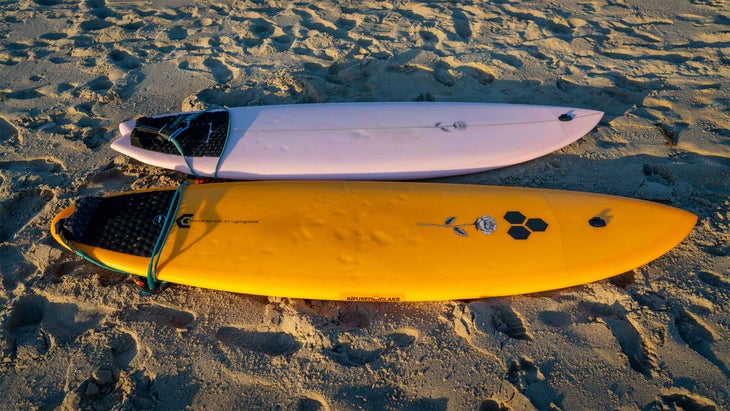
My Custom Boards
For my Channel Islands point-break board, Merrick steered me toward his a board that was designed to paddle and catch waves like a much longer board, but surf more like a shortboard. My only reservation was that I wanted something that could handle bigger, steeper, barreling waves (dare to dream). He said no problem and borrowed the thinner rails from his , which are a bit more refined and would also help with my turns.
Merrick recommended a 6-foot, 8-inch board, which would be my biggest board in years, but promised it wouldn’t surf that way. I had him add five fin-boxes instead of the standard three, so I could ride it as a thruster, a quad, or a twin (i.e. a three-fin, a four-fin, or a two-fin configuration), depending on the day. I also had the board made with (Varial just recently, tragically, went out of business due to a supply-chain interruption, when they were priced out of their foam by the aerospace industry), glassed with epoxy resin tinted Creamsicle orange, and I had a rose emblazoned on the deck.
For my Venice board, I came to Okazaki with a laundry list of what I wanted the board to do. After hearing my thoughts and watching my flailing surf videos, he thought would be a good place to start, or the as he would come to call this latest iteration of a board he’s been evolving for 22 years.
Okazaki planned to throw in a fairly moderate double concave through the tail, and a single concave around where my front foot would be. That should enhance rail-to-rail transitions, give it a little more pop, and hopefully increase speed out of turns. Guy advocated for a swallow-tail with a prominent double-wing just ahead of it, which would allow for very straight rails for speed, but then give it a nice break to pivot off of for turns. He suggested we go with a 6-foot, 2-inch, with standard polyurethane (PU) foam blank and lightweight four-ounce PU glassing. I had him throw on the same rose I put on my CI board, plus a five-fin-box setup, and picked a Pantone color that looked like bubblegum.
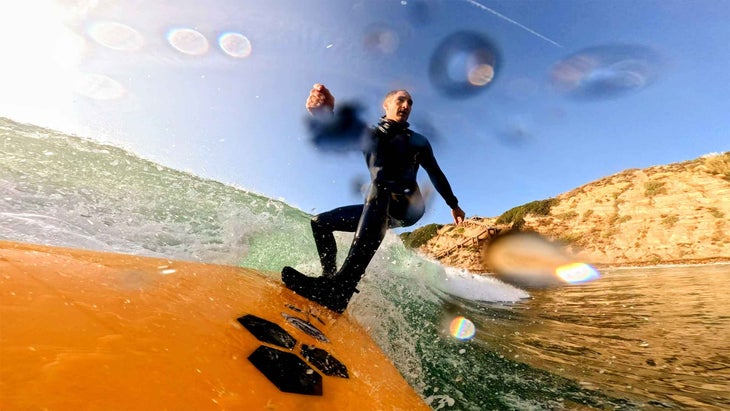
The Results
A few months later, both boards have exceeded my wildest expectations.
I’ve taken my Merrick CI board to point breaks up and down the California coast, in everything from waist-high waves to well overhead. The board has allowed me to get into waves early, then pump down the line, and really sink into my carves like I’d hoped. In the few months that I’ve had it, I’ve probably caught four of the top five longest and most memorable waves of my life.
For my Okazaki board, I gave Guy such a long list of things I wanted it to do—some of which seemed at odds with each other—and somehow he did it. It has great paddle power, but I can still duck-dive it. The board can make steep, late drops, but it also has great speed down the line. Trimming around flat sections is easy, but then it turns on a dime with very little effort and takes off again. I’m riding this board at the local spot I’ve been walking to several times a week for the last three years, and I’m having more fun out there than I ever have. What’s more important than that?
Last Advice from the Shapers
“I recommend trying to stay as local as you can,” Okazaki told me. “And that’s more than just for the shaper.” One of Okazaki’s greatest concerns is the increasing acidification of our oceans. That’s one of the reasons he uses U.S. Blanks for his foam, because they operate in Los Angeles, and because of that they’re subject to the most stringent environmental standards in the nation. It’s just a 20-minute drive from Okazaki’s shop to their factory, so the carbon footprint to get a blank from them is as minimal as it gets, and they’re fully solar-powered, too. Okazaki also works with local glassers (which most shapers usually do), which again requires minimal transport, and feeds money directly into the local surf economy.
“It’s rare these days that you get a product that’s all hand-made by skilled craftsmen and women,” Merrick mused. “It’s not your tennis racket, golf club, snowboard, or basketball that just gets pumped out by machines. People should approach it with an appreciation for the art and the craftsmanship. Once people start to appreciate that they’ll appreciate surfing as a whole even more.”


